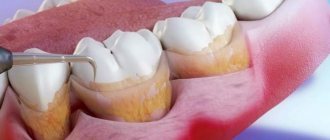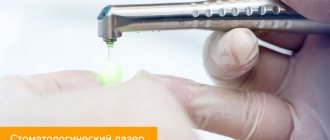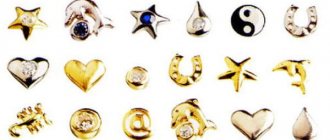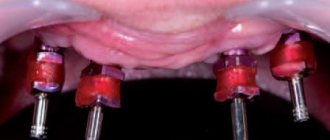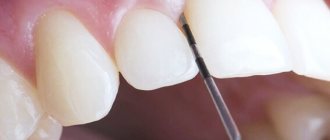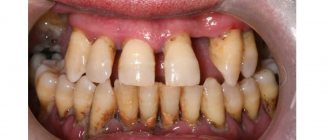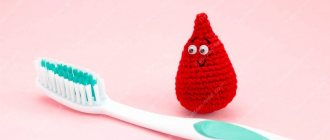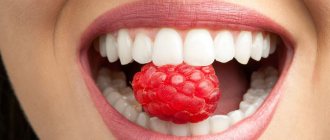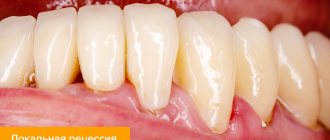How to do curettage
Curettage is a surgical operation. Plaque, stone, and pathological tissue are removed from the periodontal pocket. If necessary, osteoplastic surgery is performed. This is necessary if bone resorption has already begun.
Curettage must be carried out in the treatment of periodontitis and periodontal disease, as this is one of the most effective methods for eliminating inflammation in the gums. According to the technology of the procedure, there are two types of it:
- Open;
- Closed.
Indications for curettage:
- feeling of tension (pulsation, bloating) in the gums;
- putrid odor from the mouth that does not disappear after brushing your teeth;
- swelling, redness and soreness of the gums;
- bleeding gums under any impact, including while brushing your teeth;
- tooth mobility;
- increase in interdental spaces;
- deposition of tartar under the gum;
- destruction of periodontal tissue and jaw bone tissue (formation of replacement tissue in their place).
Curettage has contraindications. The procedure is not performed if the pocket depth is more than 6 mm, there is an abscess and pus in the periodontal pocket, as well as with thinned gums affected by fibromatosis. Obstacles to curettage include tooth mobility of degrees III–IV, infectious diseases (influenza, tonsillitis, acute respiratory infections) and any diseases in the acute stage.
Closed curettage
Can be used if the depth of the periodontal pocket does not exceed 5 mm, and pathological changes in the bones have not yet begun. When performing closed curettage, pathological tissues are exposed to ultrasound and hand instruments in the form of hooks, with the help of which granules are removed from under the gums. There is no cutting of the gums, so the procedure can be considered more gentle.
Flaws:
- The doctor performs the operation almost blindly; he does not see the subgingival space. Therefore, it is not possible to thoroughly clean the periodontal pocket in all cases.
- There is a risk of incomplete cleaning. Success largely depends on the experience of the dentist performing the procedure.
Due to its characteristics, closed curettage is suitable for mild to moderate periodontitis and periodontal disease. Sometimes it becomes the only possible method, since others cannot be used for some reason.
Transplantation of a flap from the palate
Recession flaps are usually taken from the hard palate. In this case, the graft can consist only of connective tissue, or be epithelialized. The thickness of the flap depends on the tasks and the result that needs to be achieved. Direct closure of gingival recessions requires thick flaps, while restoration of visible gingival areas is carried out using thin and epithelialized fragments.
The graft is usually taken from the area of the hard palate, which borders the canines and premolars. In this case, it is necessary to retreat 2 mm from the edge of the gum. These rules allow you to avoid crossing the palatine artery and the development of bleeding. The thickness of the mucous membrane from the donor area should not be less than three millimeters, so probing is carried out first. After obtaining a flap, the defect is sutured
Open curettage
Used if the depth of periodontal pockets is more than 5 mm. This is a surgical intervention, but compared to a closed one, the effectiveness is much higher. Since open curettage requires cutting into the gums, the operation is performed under anesthesia.
Stages:
- The doctor cuts the gum and peels it away from the tooth. After exfoliation, the tooth root is completely exposed. The dentist gets full access to the bone tissue.
- Cleaning and antiseptic treatment. The roots are cleaned of accumulated plaque and stone and polished using a burr and special pastes. After this, the tissues are treated with an antiseptic.
- Osteoplasty. This stage is not always necessary. With advanced periodontal disease, bone resorption gradually begins around the teeth, which will lead to loosening and tooth loss. In order to restore the bone, osteoplastic material is implanted.
- Suturing. After plaque removal, the gingival flap is returned to its place and sutured. A bandage with an antiseptic solution is applied on top.
Open curettage is a more complex procedure, but more effective than closed curettage. The surgeon sees the entire subgingival space and has access to bone tissue. Therefore, the quality is very high; both plaque and granulation tissue are completely removed from under the gums.
If necessary, open curettage can be performed simultaneously with flap surgery. It is indicated if the gum tissue is loose and the gum contour is disturbed. Very often, with periodontal disease, the gums begin to overhang the teeth. This violates the aesthetics of a smile. During flap surgery, the dentist removes excess mucous membrane and then sutures the gum.
Bone grafting
In severe periodontitis, there is a loss of bone tissue, which contributes to the loosening of teeth. In order to stop this process, bone grafting is used. The patient's own tissue, as well as artificial substitutes, can be used as a graft. In the first case, a section of bone can be taken from the chin, upper palate, or lower jaw. Since the patient’s own tissues are absolutely biocompatible, this method is the most effective, but requires two operations: tissue collection and transplantation.
Special bone substitutes do not have this disadvantage, so bone grafting in such cases is carried out in one stage. However, this method is characterized by a lower tissue survival rate, so it is not always possible to achieve the desired result with its help.
Rehabilitation
Curettage of periodontal pockets is a surgical operation, after which there will be a period of rehabilitation. Following the recommendations will speed up gum healing, make it less uncomfortable, and avoid complications.
Oral care rules depend on the method:
- Closed curettage. Immediately after surgery, you should not eat for several hours. On the first day, it is better to refrain from brushing your teeth with a brush and toothpaste, replacing it with rinsing. During the entire rehabilitation period, you need to monitor your diet - exclude solid foods and foods containing dyes. After curettage, there may be increased sensitivity of the teeth and gums. A special paste that your doctor will recommend will help you remove it. It is imperative to rinse your mouth with solutions of strengthening and anti-inflammatory medications.
- Open curettage. Since this surgery requires cutting into the gum, recovery takes longer. Recommendations for the first 1-2 days after surgery are the same as for closed curettage. It is very important to minimize the possible stress on the gums and teeth. It is advisable to reduce physical activity at first. Until the stitches heal, your mouth should be rinsed with solutions of antibacterial and anti-inflammatory agents. This will help speed up healing and tissue regeneration.
Plastic surgery of lip cords and frenulums
In the presence of pronounced strands of the mucous membrane, the risk of periodontal disease increases significantly. Massive folds that are fixed to the gingival papillae, when stretched, can displace them and lead to various problems. In order to prevent such conditions, band plasty is performed. Typically, the technique consists of excision of these folds and subsequent suturing of the resulting defect.
Lip frenuloplasty can be performed in the following cases:
- Pronounced tooth gap between the front incisors.
- Preparation for orthodontic treatment.
- Presence of gum recession.
- Before installing removable dentures.
- Incorrect sound pronunciation.
Surgical treatment can be performed in various ways. If the frenulum is very narrow, then it is cut transversely. If there is a wide frenulum, its excision is performed. In addition, individual sections can be moved to the desired position.
Among modern techniques, laser frenuloplasty is noted. The procedure is very quick, does not require stitches, has a short recovery period and rarely leads to complications.
After plastic surgery of the cords and labial frenulum, a period of rehabilitation begins. Typically, the patient is required to follow simple rules, which include careful oral hygiene and a certain diet. Typically, recovery takes about a week.
Flaws
Gum curettage is a simple dental operation with good results. However, it is not without its drawbacks:
- Traumaticity. Like any surgical intervention, curettage injures soft tissue.
- The need for anesthesia. Normally, the operation is performed under local anesthesia. Sedation or general anesthesia is used in extreme cases or when the patient is in panic.
- Rehabilitation. The gums heal quickly, but at this time it is necessary to follow the recommendations and take care of the oral cavity. Infection of the wound can lead to complications.
Curettage of gums in Krasnodar
In Krasnodar, you can undergo the gum curettage procedure at our Symmetry dental clinic. Our specialists have extensive experience and high qualifications, confirmed by many specialized diplomas and positive reviews from our patients. We have all the necessary modern, high-quality dental equipment.
Alternatives to curettage
Alternative technologies are suitable as prevention or in the early stages of pathology development. At the Zuub clinic they use:
- Comprehensive teeth cleaning. This is good prevention. It can be used as one of the stages of complex therapy, but not as an independent treatment. During cleaning, using ultrasound and a mixture of water, air and soda, tartar and plaque are removed from the surface of the teeth. You won't be able to empty your pockets this way.
- Treatment with the “Vector” device. A method for cleaning and disinfecting shallow periodontal pockets. In mild stages of periodontal disease, it can be used as an alternative to closed gum curettage, but it cannot replace open vector therapy. "Vector" is more effective than classic complex cleaning. It is based on a combination of exposure to an ultrasonic wave and a special suspension with abrasive particles. Since the ultrasonic wave is applied vertically, it penetrates deeply under the gum. In addition, ultrasound has a good disinfecting effect. Thanks to this, with a small depth of periodontal pockets and an undeveloped pathological process, it can give a good result.
The periodontist selects the gum treatment technology based on the clinical picture.
Come for a consultation with a dentist at the Zuub clinic.
Closing gum recessions
Closing gum recessions is carried out only by surgical methods, which involve moving donor flaps to the recession zone and plastic surgery of the existing defect. You can receive a transplant in several ways:
- Pedicled flap. In this case, the donor tissue is a nearby area of the mucous membrane. The technique is used in the presence of localized defects.
- Gingival flap. It is taken from the gum area, provided that the volume of tissue in the selected area is sufficient.
- A scrap from the sky. In this case, the donor fragment is taken from a specific area of the hard palate
To close recession zones, the method of directed tissue regeneration can be used. In this case, special membranes are used as donor tissue, which can be absorbable or non-absorbable. These membranes promote the migration of cells from natural tissues and subsequent regeneration of the damaged area.
This method does not require the formation of a donor wound, but is not suitable for all patients. To obtain a successful result, the membrane must be covered with a layer of mucous membrane, which will provide the necessary nutrition, which is not always possible. In addition, due to the long process of formation of new tissue, it is necessary to observe certain rules of oral hygiene, therefore this method requires the active and conscientious participation of the patient in the treatment process.
